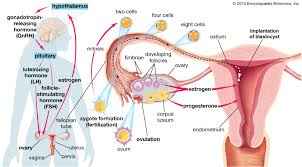
FEMALE HORMONAL SYSTEM
The hormones controlling the female reproductive system include gonadotropin-releasing hormone (GnRH), follicle-stimulating hormone (FSH) and leutenizing hormone (LH), all of which are produced in the brain; oestrogen and progesterone produced by the ovaries and the corpus luteum; and human chorionic gonadotropin (HCG) ..The main reproductive hormones are oestrogen and testosterone. Oestrogen causes eggs to mature in ovaries once a girl hits puberty. These are then released at regular intervals during the menstrual cycle. Testosterone stimulates sperm production in males..The most common consequence of aging-related hormonal changes is menopause. Around age 50, women's ovaries begin producing decreasing amounts of estrogen and progesterone; the pituitary gland tries to compensate by producing more follicle stimulating hormone (FSH).
One of progesterone's most important functions is its role in thickening the lining of the uterus each month. The enriched endometrial lining is prepared to receive and nourish a fertilized egg. If a pregnancy occurs, progesterone is produced in the placenta and levels remain elevated throughout the pregnancy.At the onset of puberty, estrogen plays a role in the development of so-called female secondary sex characteristics, such as breasts, wider hips, pubic hair and armpit hair. Estrogen also helps regulate the menstrual cycle, controlling the growth of the uterine lining during the first part of the cycle.
At the end of the lesson students should learn about function of female reproductive hormones.


